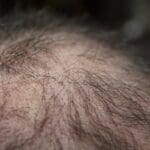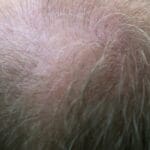Hair loss is a natural part of the aging process, and it can be a challenging experience for many individuals. However, it is important to remember that hair loss does not define your worth or beauty. In this article, we will explore the connection between hair loss and aging and provide tips on how to accept and embrace this natural process with grace and confidence.
As we age, our hair follicles gradually shrink, leading to thinner and weaker hair strands. This can result in various types of hair loss, including male and female pattern baldness, as well as general thinning of the hair. While these changes can be distressing, it is crucial to understand that they are a normal part of the aging process.
Accepting and embracing hair loss with grace and confidence starts with shifting our mindset. Instead of viewing hair loss as a negative aspect, we can choose to see it as a sign of wisdom and maturity. Just like the lines on our face, our hair loss tells a story of our journey through life.
One way to cultivate self-acceptance and build confidence is through practicing self-care. Taking care of your overall well-being, both physically and mentally, can have a positive impact on how you perceive yourself. Engage in activities that bring you joy, practice relaxation techniques, and ensure you are getting enough rest and exercise.
Another way to embrace hair loss is by exploring your personal style. Experiment with different hairstyles, headscarves, wigs, or accessories that enhance your appearance and express your individuality. This can be an exciting opportunity to reinvent yourself and discover new looks that make you feel confident and beautiful.
While outer beauty is important, it is equally crucial to focus on inner beauty and wellness. Take the time to nourish your body with a healthy diet, stay hydrated, and prioritize self-care rituals that make you feel good. Remember, true beauty radiates from within, and by taking care of yourself, you can enhance your overall well-being.
Seeking support from friends, family, or support groups can also be incredibly beneficial when navigating the emotional challenges of hair loss and aging. Connecting with others who have gone through similar experiences can provide a sense of solace and understanding. Sharing your feelings and concerns with loved ones or professionals can help alleviate the emotional burden and provide valuable guidance.
Ultimately, embracing the process of hair loss and aging with grace and confidence is about accepting yourself as you are and recognizing the unique beauty that resides within you. Remember, your worth is not determined by the amount of hair on your head, but by the love, kindness, and compassion you carry in your heart.
Understanding Hair Loss
Understanding Hair Loss
Hair loss is a natural part of the aging process and can occur in both men and women. It is important to understand the causes and types of hair loss commonly associated with aging in order to embrace this process with grace and confidence.
Causes of Hair Loss
There are several factors that contribute to hair loss as we age. One of the most common causes is genetics, with male and female pattern baldness being the primary culprits. This type of hair loss is hereditary and typically starts with a receding hairline or thinning at the crown of the head.
Another cause of hair loss is hormonal changes. As we age, our hormone levels fluctuate, which can lead to hair thinning or shedding. This is particularly common in women during menopause.
Additionally, certain medical conditions and medications can also contribute to hair loss. Conditions such as alopecia areata, thyroid disorders, and autoimmune diseases can cause hair to fall out in patches or overall thinning. Medications such as chemotherapy drugs and some antidepressants can also have hair loss as a side effect.
Types of Hair Loss
There are different types of hair loss that are commonly associated with aging. Male pattern baldness, also known as androgenetic alopecia, is characterized by a receding hairline and thinning at the crown of the head. Female pattern baldness, on the other hand, typically results in overall thinning of the hair rather than a receding hairline.
Thinning hair is another common issue that many people experience as they age. This can be caused by a variety of factors, including hormonal changes, nutritional deficiencies, and damage from styling practices.
It is important to note that while hair loss can be distressing, it is a natural part of the aging process and does not define your beauty or worth. By understanding the causes and types of hair loss, you can better navigate this journey with acceptance and confidence.
Coping Strategies
Coping with hair loss can be an emotional journey, but there are strategies you can employ to navigate this process with grace and confidence. Here are some tips and techniques to help you manage the emotional impact of hair loss:
- Self-Acceptance: Accepting the changes in your appearance is an essential step in coping with hair loss. Embrace the fact that hair loss is a natural part of the aging process and remember that your worth goes beyond your physical appearance.
- Seeking Support: Reach out to friends, family, or support groups who can provide understanding and empathy. Sharing your experiences and feelings with others who are going through similar challenges can be incredibly comforting.
- Exploring Hair Restoration Options: If you feel inclined, explore different hair restoration options available to you. Consult with a professional to discuss potential treatments, such as medications, hair transplants, or non-surgical solutions. Understanding your options can empower you to make informed decisions about your hair journey.
Remember, coping with hair loss is a personal and unique journey for everyone. It’s important to find strategies that work best for you and prioritize your emotional well-being throughout the process. By embracing self-acceptance, seeking support, and exploring hair restoration options, you can navigate the emotional impact of hair loss with grace and confidence.
Self-Acceptance and Confidence
Self-acceptance and confidence are essential when facing hair loss. It is important to remember that hair loss is a natural part of the aging process, and embracing it can lead to a greater sense of self-acceptance and confidence. Here are some ways to cultivate self-acceptance and build confidence in the face of hair loss:
- Practicing self-care: Taking care of yourself both physically and emotionally can greatly impact your self-esteem. Engage in activities that make you feel good, such as exercising, eating a balanced diet, and getting enough rest.
- Embracing personal style: Experimenting with different hairstyles, headscarves, wigs, and accessories can enhance your appearance and allow you to express your individuality. Find a style that makes you feel confident and comfortable.
- Focusing on inner beauty: Remember that true beauty comes from within. Cultivate a positive mindset and focus on your inner qualities and strengths. Engage in activities that bring you joy and fulfillment, and surround yourself with positive influences.
By practicing self-care, embracing personal style, and focusing on inner beauty, you can cultivate self-acceptance and build confidence in the face of hair loss. Remember that your worth is not determined by your hair, and embracing your natural beauty can lead to a greater sense of self-empowerment and confidence.
Exploring Personal Style
Exploring personal style is an exciting and empowering journey that allows you to embrace your unique identity and express your individuality. When it comes to hair loss and aging, experimenting with different hairstyles, headscarves, wigs, and accessories can not only enhance your appearance but also boost your confidence and help you embrace the process with grace.
One way to explore personal style is by trying out different hairstyles. Whether you have short hair, long locks, or are experiencing thinning hair, there are countless styles that can complement your features and reflect your personality. From pixie cuts to braids, updos to tousled waves, the options are endless. Don’t be afraid to consult with a hairstylist who specializes in hair loss to find the perfect cut and style for you.
Headscarves are another fantastic option for adding a touch of elegance and flair to your look. They come in a variety of colors, patterns, and fabrics, allowing you to experiment with different styles and create versatile looks. Whether you opt for a classic turban or a chic head wrap, headscarves can be a stylish accessory that not only covers any hair loss but also adds a unique touch to your ensemble.
Wigs are a popular choice for individuals experiencing significant hair loss. They offer the opportunity to completely transform your appearance and try out different hair colors, lengths, and textures. High-quality wigs made from natural-looking materials can give you a seamless and realistic look, allowing you to feel confident and beautiful. It’s important to find a wig that matches your skin tone and face shape for the most flattering result.
Accessories play a crucial role in enhancing your personal style and expressing your individuality. From statement earrings to bold necklaces, accessories can draw attention away from hair loss and highlight other features. Additionally, hats, caps, and headbands can be fashionable and functional options for protecting your scalp from the sun while adding a touch of style to your overall look.
Remember, exploring personal style is all about embracing your uniqueness and finding what makes you feel confident and beautiful. Don’t be afraid to step out of your comfort zone and try new things. Experiment with different hairstyles, headscarves, wigs, and accessories to discover the looks that make you feel your best. Embrace the process with grace and confidence, and let your personal style shine.
Inner Beauty and Wellness
Inner beauty and wellness play a crucial role in maintaining overall well-being and radiating beauty from within. Taking care of oneself is not only about external appearances but also about nurturing the mind, body, and soul. It involves adopting healthy lifestyle choices, practicing self-care, and cultivating a positive mindset.
Self-care is an essential component of inner beauty and wellness. It encompasses activities that promote physical, mental, and emotional well-being. This can include engaging in regular exercise, getting enough sleep, eating a balanced diet, and practicing relaxation techniques such as meditation or yoga. By prioritizing self-care, individuals can enhance their overall health and well-being, which in turn contributes to their inner beauty.
Healthy lifestyle choices also play a significant role in maintaining inner beauty. This involves making conscious decisions to fuel the body with nutritious foods, staying hydrated, and avoiding harmful substances such as excessive alcohol or tobacco. By nourishing the body from within, individuals can achieve a natural glow and radiance that reflects their inner well-being.
A positive mindset is another key aspect of inner beauty and wellness. Cultivating a positive outlook on life can have a profound impact on one’s overall well-being. It involves practicing gratitude, embracing optimism, and reframing negative thoughts into positive ones. By adopting a positive mindset, individuals can enhance their self-confidence, resilience, and overall sense of happiness, which ultimately contributes to their inner beauty.
In summary, inner beauty and wellness are essential in maintaining overall well-being and radiating beauty from within. By prioritizing self-care, making healthy lifestyle choices, and cultivating a positive mindset, individuals can enhance their inner beauty, which will naturally shine through in their external appearance.
Seeking Support
Seeking support from friends, family, or support groups can have numerous benefits when navigating the emotional challenges of hair loss and aging. It is important to remember that you are not alone in this journey, and connecting with others who are going through similar experiences can provide a sense of comfort and understanding.
One of the primary benefits of seeking support is finding solace in shared experiences. Talking to others who have also experienced hair loss and aging can help you feel less isolated and more validated in your feelings. It can be incredibly reassuring to know that others have faced similar challenges and have found ways to cope and embrace their changing appearance.
Support from loved ones, such as friends and family, can also play a crucial role in helping you navigate the emotional impact of hair loss. They can provide a listening ear, offer words of encouragement, and remind you of your inherent worth and beauty. Their support can help you build resilience and confidence as you navigate this new chapter in your life.
In addition to seeking support from friends and family, joining support groups specifically tailored to hair loss and aging can be immensely beneficial. These groups provide a safe and understanding space for individuals to share their experiences, seek advice, and find support from others who are going through similar challenges. Support groups can offer a sense of community and belonging, as well as valuable resources and information about coping strategies and hair restoration options.
Remember, seeking support is not a sign of weakness but rather a courageous step towards embracing your journey with hair loss and aging. It is an opportunity to connect with others, gain valuable insights, and find the strength to navigate this process with grace and confidence.
Hair Restoration Options
Hair restoration options offer hope to those experiencing hair loss, providing a range of solutions to address the issue. Whether you’re looking to slow down hair loss or promote hair regrowth, there are several options available, including medications, hair transplants, and non-surgical treatments. Let’s explore these options in more detail and discuss their effectiveness and considerations.
Medications: Medications are a common choice for individuals seeking to combat hair loss. There are various oral and topical medications available that aim to slow down hair loss and stimulate hair regrowth. One such medication is minoxidil, which is applied topically to the scalp. It has been shown to be effective in promoting hair growth in both men and women. Another medication, finasteride, is taken orally and works by blocking the hormone responsible for hair loss in men. It is important to note that these medications may have potential side effects, so it is essential to consult with a healthcare professional before starting any medication regimen.
Hair Transplants: Hair transplants are a surgical option for individuals looking for a more permanent solution to hair loss. This procedure involves removing hair follicles from a donor area, typically the back or sides of the scalp, and transplanting them to the balding or thinning areas. Hair transplants can provide natural-looking results and are considered a long-term solution. However, it is important to note that hair transplants require careful consideration and consultation with a qualified surgeon, as the procedure may not be suitable for everyone.
Non-Surgical Treatments: Non-surgical treatments offer alternatives to invasive procedures for hair restoration. These treatments include laser therapy, scalp micropigmentation, and platelet-rich plasma (PRP) therapy. Laser therapy involves using low-level laser devices to stimulate hair follicles and promote hair growth. Scalp micropigmentation is a non-surgical tattooing technique that creates the appearance of a closely shaved head or adds density to thinning hair. PRP therapy involves injecting platelet-rich plasma derived from the patient’s blood into the scalp to stimulate hair growth. These non-surgical treatments can be effective for certain individuals and may be a suitable option for those who prefer non-invasive methods.
In conclusion, hair restoration options provide individuals with a range of choices to address hair loss concerns. Medications, hair transplants, and non-surgical treatments each have their own effectiveness and considerations. It is important to consult with professionals and explore the available options to determine the most suitable approach for your specific needs and goals. Remember, embracing the process of hair loss with grace and confidence is key, and there are solutions available to help you feel your best.
Medications and Treatments
When it comes to addressing hair loss, there are various medications, topical treatments, and therapies available that aim to either slow down the process or promote hair regrowth. These options can be effective in managing hair loss and restoring confidence. However, it’s important to understand their potential side effects and considerations before embarking on any treatment journey.
One common medication used for hair loss is minoxidil, which is available over-the-counter and comes in the form of a topical solution or foam. Minoxidil is applied directly to the scalp and works by stimulating hair follicles, promoting hair growth, and preventing further hair loss. It is generally well-tolerated, but some individuals may experience scalp irritation or unwanted hair growth in other areas of the body.
Another medication often prescribed for hair loss is finasteride, which is available in pill form. Finasteride works by inhibiting the conversion of testosterone into dihydrotestosterone (DHT), a hormone that contributes to hair loss. It can be effective in slowing down hair loss and promoting regrowth, particularly in men with male pattern baldness. However, it is important to note that finasteride is not suitable for use by women and may have side effects such as decreased libido or erectile dysfunction in some individuals.
In addition to medications, there are also various topical treatments and therapies available for hair loss. These include shampoos and conditioners that contain ingredients like ketoconazole or saw palmetto, which are believed to have anti-hair loss properties. While these products may help improve the overall condition of the hair and scalp, their effectiveness in promoting significant hair regrowth is still debated.
Other therapies for hair loss include low-level laser therapy (LLLT) and platelet-rich plasma (PRP) therapy. LLLT involves the use of specialized devices that emit laser light to stimulate hair follicles and promote hair growth. PRP therapy, on the other hand, involves injecting a concentrated solution of the patient’s own platelets into the scalp to stimulate hair growth. These therapies may show promising results for some individuals, but more research is needed to determine their long-term effectiveness.
It is important to consult with a healthcare professional or a dermatologist before starting any medications or treatments for hair loss. They can assess your individual situation, recommend the most suitable options, and guide you through the potential side effects and considerations associated with each treatment. Remember, everyone’s experience with hair loss and response to treatments may vary, so it’s essential to approach the process with patience and realistic expectations.
Hair Transplants and Non-Surgical Solutions
Hair Transplants and Non-Surgical Solutions
When it comes to addressing hair loss, there are a variety of options available, including surgical hair transplant procedures and non-surgical alternatives. Let’s take a closer look at these solutions and explore their benefits and limitations.
Surgical hair transplant procedures involve the transplantation of hair follicles from one area of the scalp to another. This procedure is typically recommended for individuals with significant hair loss or baldness. During the procedure, hair follicles are harvested from a donor site, usually the back of the head, and implanted into the balding areas. Over time, these transplanted follicles grow new hair, resulting in a fuller and more natural-looking head of hair.
While surgical hair transplants can provide long-lasting results, it’s important to note that they are invasive procedures that require a skilled surgeon. The success of the transplant depends on factors such as the quality of the donor hair, the surgeon’s expertise, and the patient’s overall health. Additionally, there may be a recovery period following the procedure, during which the scalp needs time to heal.
On the other hand, non-surgical alternatives offer a less invasive approach to hair restoration. Laser therapy is one such option, which involves the use of low-level laser light to stimulate hair growth. This treatment can be performed in a clinical setting or even at home with the use of handheld devices. Laser therapy is believed to improve blood circulation to the hair follicles, promoting hair growth and reducing hair loss.
Another non-surgical solution gaining popularity is scalp micropigmentation. This technique involves the application of pigments to the scalp to create the illusion of hair follicles. It is a non-invasive procedure that can be used to camouflage areas of thinning hair or create the appearance of a closely shaved head. Scalp micropigmentation can be a suitable option for individuals who prefer a buzzed or shaved hairstyle.
While non-surgical solutions may offer convenience and require less downtime compared to surgical procedures, it’s important to manage expectations. Results from non-surgical treatments may vary, and multiple sessions may be required to achieve the desired outcome. It’s also worth noting that these treatments may not be suitable for everyone, and it’s advisable to consult with a professional to determine the most appropriate option based on individual circumstances.
Frequently Asked Questions
- What causes hair loss?
Hair loss can be caused by various factors, including genetics, hormonal changes, medical conditions, and certain medications. It is important to consult with a healthcare professional to determine the underlying cause of your hair loss.
- Is hair loss a natural part of aging?
Yes, hair loss is a common and natural part of the aging process. As we age, our hair follicles shrink and produce thinner and shorter hair strands. This can result in overall thinning of the hair and, in some cases, baldness.
- Can hair loss be prevented?
While it may not be possible to prevent hair loss entirely, there are steps you can take to promote hair health and minimize its impact. Maintaining a balanced diet, avoiding excessive heat and chemical treatments, and managing stress levels can all contribute to healthier hair.
- Are there any effective treatments for hair loss?
There are various hair restoration options available, including medications, hair transplants, and non-surgical treatments. The effectiveness of these treatments may vary depending on the individual and the underlying cause of the hair loss. It is best to consult with a healthcare professional to determine the most suitable treatment option for you.
- Can wearing wigs or hairpieces help with hair loss?
Wigs and hairpieces can be a great temporary solution for individuals experiencing hair loss. They can help enhance appearance, boost confidence, and provide the opportunity to experiment with different hairstyles. It is important to choose high-quality wigs or hairpieces that look natural and are comfortable to wear.
- Is hair loss only a problem for men?
No, hair loss can affect both men and women. While male pattern baldness is more common in men, women can also experience hair thinning and loss due to hormonal changes, genetics, and other factors. It is important to remember that hair loss does not define one’s beauty or worth.
- How can I cope with the emotional impact of hair loss?
Coping with hair loss can be challenging, but there are strategies that can help. Building self-acceptance and confidence, seeking support from loved ones or support groups, and exploring different styling options can all contribute to a positive mindset and emotional well-being.








Leave a Reply